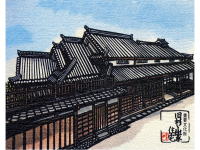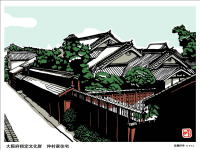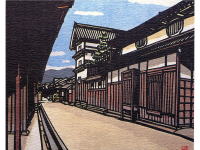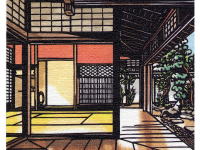富田林寺内町の探訪
I'm glad to intorduce an old town, Jinaimachi, Tondabayashi, Osaka, Japan as a national historic district and heritage site.
It takes 30 minutes from Osaka city to Tondabayashi station by Kintetsu railways. A 10-minutes walk will take you to the historic town.
ギャラリー
Former Sugiyama Residence, National important cultural property
| 【Tourist guide to Jinaimachi town, Tondabayashi, a historic district and heritage site of Japan - Sugiyama residence, indoors and interior decorations】 | ||||
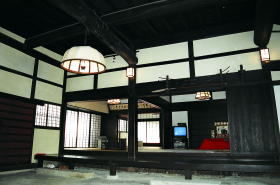 |
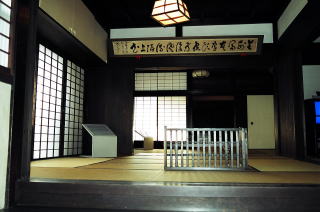 |
|||
|
Attractions: Features of the building: |
||||
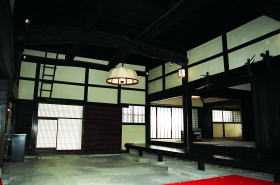 |
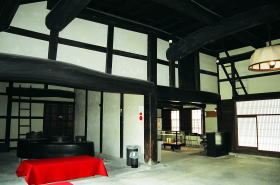 |
|||
| Earthen floor (center) , Daidoko and Koushi-no-ma (right) | Kamaya or kichen(left) and Shimomise (right) | |||
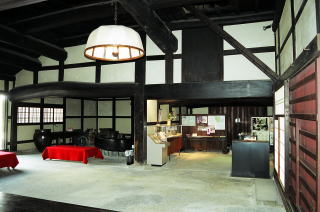 overhead lighting |
Kamaya (left hand back) Countyside farmhouse-style kitchen seen in Minami-Kawachi region. The lower height of the beams prevent the smoke blown out of the kitchen. Servant room (mezzanine floor) The servant room was used for as many as 70 employees who were engaged in the brewing industry. The employees climbed up and down over the ladder at the time. Attic The attic was used for a storage warehouse of straw and turf. |
|||
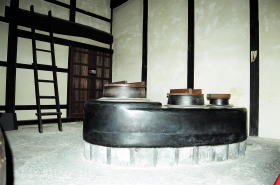 |
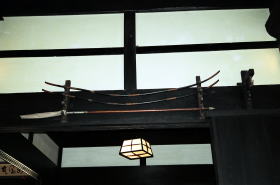 |
|||
| Kamado (Cooking stove) on the earthen floor There used to be 9 stations at that time which has been confirmed from drawings of the cooking stove.The three stoves (photo) have been restored in plaster during the dismantling repair. Ladder for climibing back and forth to the mezzanine room of the servants has propped up on the left. |
Spears that were placed on the rack in Daidoko-no-ma room |
|||
 |
 |
|||
| Koushi-no-ma room(left) and Daidoko-no-ma(right) | Koushi-no-ma room | |||
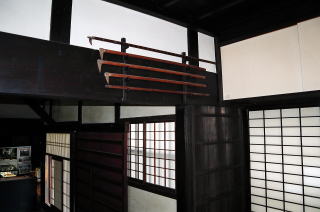 |
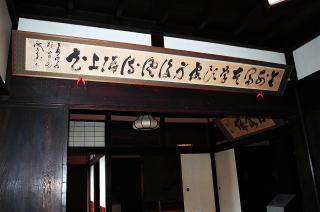 |
|||
| Koushi-no-ma room Spears having been placed on the beam |
Bokuseki, or Indian ink calligraphy by Mr. Tesshuu Yamaoka in Koushi-no-ma room. Mr. Teshuu Tesshuu Yamaoka, a well-known master of sword, Zen and calligraphy, visited Sugiyama residence in the Meiji era and the work was presented for Sugiyama family. | |||
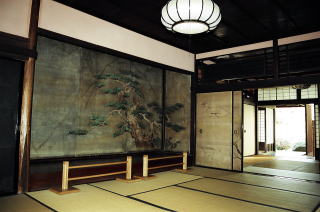 |
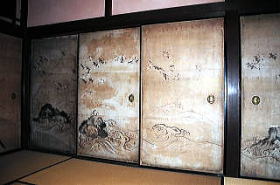 |
|||
| Oodokoo-ma, Sukiya style architecture The wall paintings "Oimatsu (Old pine tree)" was drawn by Mt. Moriaki Kano during Bunka-Bunsei period. The room was designed to resemble a Noh play stage. The pillars are showing the elegant architecture of the Kyoto-style. Floorboards in the large alcove are made of zelkova, a pair of single plates. |
Oodokoo-ma Sliding door picture depicting plovers'soaring. It is said that Yuuchidori, another pseudonym of Tsuyuko Isonokami has been derived from the theme of this picture.Yuuchidori literally means plover in the evening. |
|||
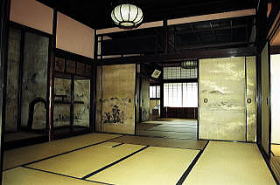 |
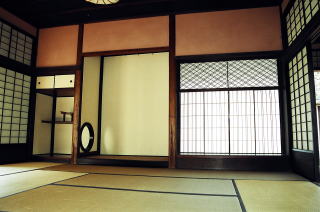 |
|||
| Overlooking Oodoko-no-ma | Oku- Zasiki The building was extendxed about 270 years ago. Chigaidana(left), Alcove(Center), and Shoin(left) are raley buillt as aligned in a straight line. |
|||
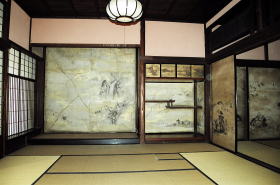 |
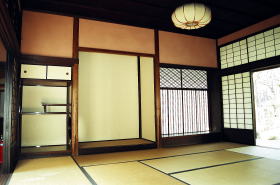 |
|||
| Zashiki (Guest room) Indiain ink paintings by Mr. Moriaki Kyozan Kano. |
Oku-Zashiki(Guest room) Juraku walls are reddish by using the Osaka soil. |
|||
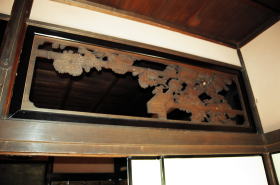 |
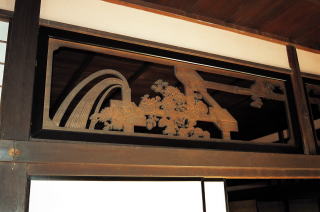 |
|||
| Elaborate sculpture of Transom called Ranma (One side) Openwork of chrysanthemum with Satsuma cedar by Mr. Shunboku Ooka, Kano school. |
Elaborate sculpture of Transom called Ranma (The other side) Openwork of chrysanthemum with Satsuma cedar by Mr. Shunboku Ooka, Kano school. |
|||
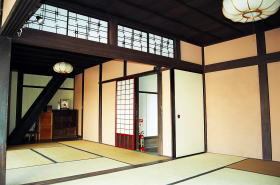 |
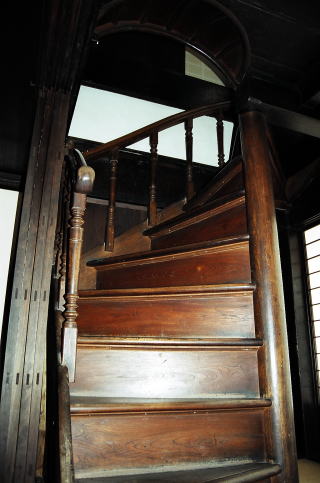 Spiral Staircase |
|||
| Tsuno-ya room The buidling extending towards the yard was named after animal's horn called tsuno in Japanese. |
||||
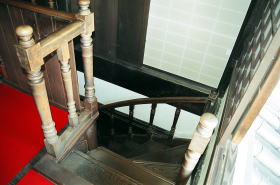 Spiral Staircase |
||||
| 【Tourist guide to Jinaimachi town, Tondabayashi, a historic district and heritage site of Japan - Sugiyama residence,main building】 | ||||
| 【Tourist guide to Jinaimachi town, Tondabayashi, a historic district and heritage site of Japan - Sugiyama residence, indoors and interior decorations】 | ||||
| 【Tourist guide to Jinaimachi town, Tondabayashi, a historic district and heritage site of Japan - Sugiyama residence, garden】 | ||||
| 【Tourist guide to Jinaimachi town, Tondabayashi, a historic district and heritage site of Japan - Sugiyama residence, kirie artcrafts by Mr. Yoshiyuki Kondo】 | ||||
|
||||
Information
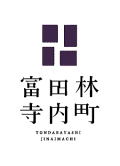
National important cultural property
Designated in 1983
Open to the public (admission required)
Year built: 1644
Address:
Zip code 584-0033
Tondabayashi cho, 14-31, Tondabayashi city, Osaka Pref.
Phone: 0721-23-6117
Open Hours:
10:00 to 17:00
Closed:
Monday
December 28 to January 6.
Inquiry:
Cultural Property Division in Tondabayashi City Hall
Phone: 0721-25-1000 (ext. 508)
History:
Sugiyama family was the leading founder of Tondabayashi village among the
eight founders. The family did business as Wataya. About 450 years ago,
the family started involved in new development of the village and initially
ran a cotton wholesaler. Then they started a brewing industry in the mid-Edo
period and greatly prospered as he served as a head of the brewing industry in Kawachi region. The family went out of the
business in the mid-Meiji era, facing a new liquor tax introduction as well as a
lack of competition with the large-scale production areas such as Nada
and Fushimi. The residence is the birthplace of Ms. Tsuyuko Isonokami,
a female poet of Myojo school (Her real name was Takako Sugiyama, 1882ー1959)
Since the owner tried to sell the land and buildings to a real estate agent,
Tondabayashi city decided to purchase them at 166 million yen in June 1983
to preserve the valuable cultural property. Thereafter dismantling repair
was carried out at the cost of 230 million yen in two-and-a-half years.
The earthen floor of the main house building was totally dismantled and
the tatami rooms of the main house were half demolished at the time of
repair. The property was designated as an important cultural property of
the country on October 26, 1983 as a typical architecture of farmer’s house
inMinami-Kawachi region.
Tondabayashi city has currently owned and managed the property and it has
been open to the public since 1987. In Jinaimachi, the ex. Sugiyama residence
designated as an important cultural property, ex. Tanaka residence registered
as a tangible cultural property and Katsuma residence are open to the public
inside the building. The Katsuma residence is now open to the public as
an Italian restaurant from October 2012.
The ex. Sugiyama residence was used as a film location and shooting of
the movie titled Maihime directed by Mr. Masahiro Shinoda in 1989, starring
Hiromi Go was held.
Trade name:Wataya
Sugiyama family’s records:
Sugiyama family’s records have been in exhibition categorized as a "
document of the village" and as a "document of the sake brewery"
in the Kyoto University Museum.
Tour guide by volunteers:
Guided tour service by local volunteers is available for visitors in group.
Advanced booking is required.
Please contact the Jinaimachi Visitor Center (Jinaimachi Kouryuukan) for
inquiries.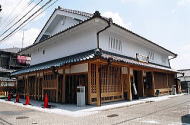
Jinaimachi Kouryuukan,
Town Community Center
(Visitor Center)
Address
9-29, Tondabayashi-cho, Tondabayashi city, Osaka, 584-0033, Japan
TEL.+81-(0)721-26-0110
FAX.+81-(0)721-26-0110
open 10a.m. until 5 p.m.
closed on Monday
